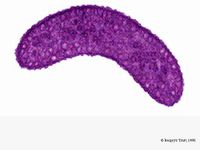Rhodospirillum rubrum
A Microbial Biorealm page on the genus Rhodospirillum rubrum
Classification
Higher order taxa
Kingdom: Bacteria
Phylum: Proteobacteria
Class: Alphaproteobacteria
Order: Rhodospirillales
Family: Rhodospirillaceae
Genus: Rhodospirillum
Species
Rhodospirillum rubrum
NEUF2011
Description and significance
Rhodospirillum rubrum is a Gram-negative, mesophilicproteobacteria. Its optimal growth temperature is 25-30 degrees Celsius. It has multi-layered outer envelopes, which contain mostly unsaturated, but some saturated fats in its cell wall. R. rubrum is a spirilla, meaning it has a spiral-shape. It is polarly flagellated, and therefore motile. Its length is 3-10 um, with a width of 08-1.0 um.
R. rubrum is a facultative anaerobe. Depending on the presence of oxygen, it can undergo alcoholic fermentation or aerobic respiration. It also is capable of photosynthesis and contains carotenoid and bateriochlorophyll in its chromatophore particles. These molecules help to absorb light and convert it to energy and also give it its distinct purple-red color under anaerobic conditions. R. rubrum is colorless under aerobic conditions.
Although photosynthesis is active under aerobic conditions, it is generally suppressed in the presence of O2. Sulfur is a major byproduct of photosynthesis, not O2. R. rubrum can grow heterotrophically or autotrophically when photosynthetic. Unlike many plants, R. rubrum contains no chlorophyll a (absorption spectra 430-662 nm). However, it does contain chlorophyll b (absorption spectra 660-680 nm) and bacteriochlorophylls (800-925 nm). This allows it to utilize more energy from the electromagnetic spectra. R. rubrum also oxidizes carbon monoxide (CO) with hydrogen gas as the pathway’s end product, and can use sulfide at low concentrations as an electron donor in carbon dioxide reduction. Additionally, it is a nitrogen fixing bacteria; it uses nitrogenase to convert atmospheric nitrogen gas to ammonia.
R. rubrum is commonly found in mud, pond water, and sewage. It has not been found to infect humans or animals.
There are several applications of R. rubrum in the field of biotechnology. It is a model system of light to chemical energy conversion and for its nitrogen fixing pathways. It is also the subject of radiation resistance studies. It can be used in several ways for consumption, as well. The proteobacteria may be a source of animal food and agricultural fertilizer. Another important role in research includes the production of vitamins. It is also being researched for its production of biological plastic from precursors of poly-hydroxy-butric-acid. R. rubrum may also be a contributor in biological hydrogen fuels, mainly through its evolution of the enzyme nitrogenase.
Genome structure
The genome's sequencing is finished. It consists of a circular chromosome with 4,352,825 base pairs, 65% of which are guanine-cystosine pairs. There is also a plasmid with 53,732 base pairs with 60% guanine-cytosine. In total, there are 3,850 protein coding genes and 83 RNA genes. Of these genes, 6.9% are transcription-related; 4.6% translation, ribosome structure, and biosynthesis; 4.0% replication, recombination and repair; 7.9% signal transduction mechanisms; 5.9% cell wall and membrane biogenesis; 6.6% energy production and conversion; 5.0% carbohydrate transport and metabolism; 9.9% amino acid transport and metabolism; 4.7% coenzyme transport and metabolism; 3.7% lipid transport and metabolism; and 6.5% inorganic ion transport and metabolism.
Ecology
Rhodospirillum Rubrum is found in many natural aquatic environments such as ponds, lakes, streams, and standing water. R. Rubrum is also often found in mud and sewage.
Cell structure and metabolism
Interesting features of cell structure; how it gains energy; what important molecules it produces.
Basic Metabolism Versatile organism that can obtain energy through alternative mechanism.
Two main distinctive metabolisms that Rhodospirillum Rubrum can carry out: Competition between respiratory and photosynthetic process is determine by the present of light and energy.
Rhodospirillum can grow in dark chemo-tropical environment with the presence of O2 or they can grow in a photo-tropical environment without O2.
Phototrophically grown Rhodospirillum contain photosynthetic electron transport and ATP synthesis enzymes in their membrane and contain a membrane bound pyrophosphatase.
Photosynthetic process – Donation of a Hydrogen from an organic substrate to an oxidizing substance
Entire Complement of photoreactive pigments ( bacteriochlorophyll and carotenoids) in the photosynthetic organism ……. was bound to large particles known as chromatophores. In (Schachman, Pardee and Stanier, 1952)
Chromatophores: flattened disks about 110mu in diameter. (Schachman 1952)
Chromatophores are not present in cells from young cultures (Hickman and Frenkel 1959) Chromatophores contain Choline phospholipids and are rich in cardiolipin (diphosphatidyl glycerol) and galactosyl diglyerides which are major components of chloroplast lipids (Benson, Wintermans, and Wiser 1959 and Benson 1961) Chromatophores are complete with respect to components of the electron transport chain containing various cytochromes, flavin and pyridine nucleotide (Newton and Newton 1957, Hulcher and Conti, 1960, Kamen 1961) Anaerobic light dependent phosphorylation of adenosine diphosphate (ADP) to (ATP) so the entire activity is catalysed by the chromatophores (Frenkel 1956)
Dark: Anabolic Processes - in which oxidation by O2 from an organic substrate provides the energy needed.
Chemotrophically dark grown Rhodospirillum contain low concentration of bacteriochlorophyII and carotenoids and has no bound pyrophosphatase in their membrane.
Rhodospirillum Rubrum is found in many natural settings such as pond water, mud, or sewage.
Habitat; symbiosis; contributions to the environment.
Pathology
How does this organism cause disease? Human, animal, plant hosts? Virulence factors, as well as patient symptoms.
Current Research
Some journal articles I found interesting.
1. Evidence that Ubiquinone Is a Required Intermediate for Rhodoquinone Biosynthesis in Rhodospirillum rubrum
2. Effect of Perturbation of ATP Level on the Activity and Regulation of Nitrogenase in Rhodospirillum rubrum
3. Modes of hydrogen production in the photosynthetic bacterium, Rhodospirillum rubrum
- Renewable energy
Cool Factor
Describe something you find "cool" about this microbe.
Possible topics:
Photosynthetic, but does not have light harvesting complex 2 (LHC2), which is commonly found in many photosynthetic bacteria.
References
Edited by student of Iris Keren

